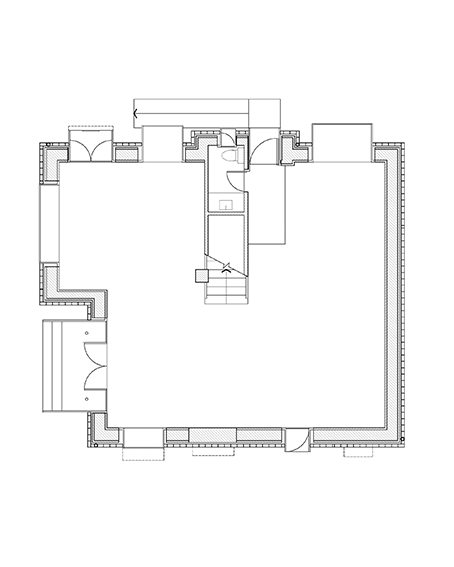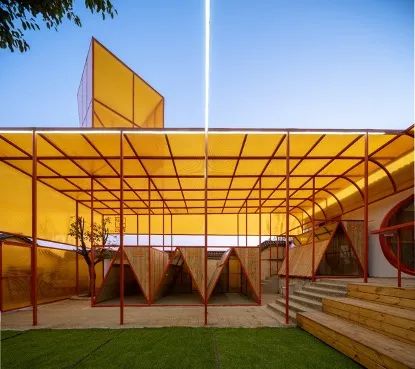中国本土建筑实践:传统在小尺度中的5种解题方式
Chinese Indigenous Architecture Practice: 5 ways of solving problems in small-scale Traditional Architecture
废墟是建筑的尽头,同时也是建筑的起源。
——藤本壮介
随着近年来城市建设从增量发展模式到存量更新模式的逐渐转化,越来越多的城市历史片区、工业遗产,或者传统村落和古民居,面临着建筑和场景的更新和功能的激活。但如何将旧房子看做一个具有延续性的有机体,并在此基础上以当代设计激活它的生命力、传递出它的历史价值,对于今天的设计师来说都是需要研究的课题和值得实践的方向。本文选择五个典型设计案例,开启对小尺度中,中国本土建筑师处理当代设计与传统的不同解题方式的观察。
01
章堰文化馆 | 水平线设计
Zhang Yan Cultural Museum | Horizontal Design
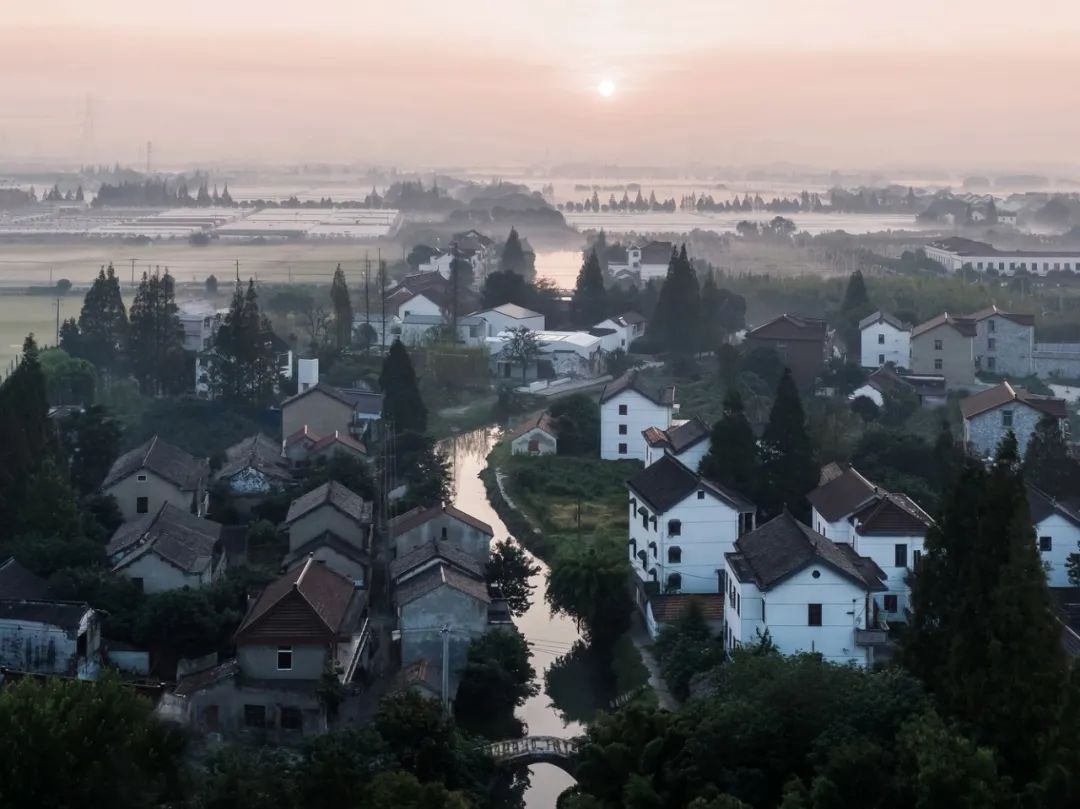
章堰村位于上海市西郊崇谷镇。近几十年来,该村的人口统计发生了巨大变化,年轻人口迅速减少,其结果是使原来的村落恶化。该镇包括民国时期的清代民居和建国后修建的两层或三层房屋。作为新的郊区发展政策的一部分,章堰村与中国许多其他乡镇一样,进行了整修和复兴。“修复与保护,从传统中生长延续和扩展”是我们对章堰村和中国其他类似村庄进行更新和修复的策略。它的目的不是主观控制和重建,也不是为了修复旧的东西而去修复。相反,它努力遵循历史的发展和脉络,将当代的需求和意识带入村庄,重新组织布局,对商业生态进行规划布置,并在新旧之间建立对话。古建筑体现了古村落的历史和文化。它们必须保留并通过加强和保护加以修缮。对于那些内部空间不再可用的残旧建筑物,“清理”损坏的部分可以有效保留功能部分。因此,“新”自然会脱离其脉络自然发展,可以与“旧”共存。新建筑代表着新时代,特别是新功能。博物馆设有几处当代建筑,建在该场地的空旷部分。
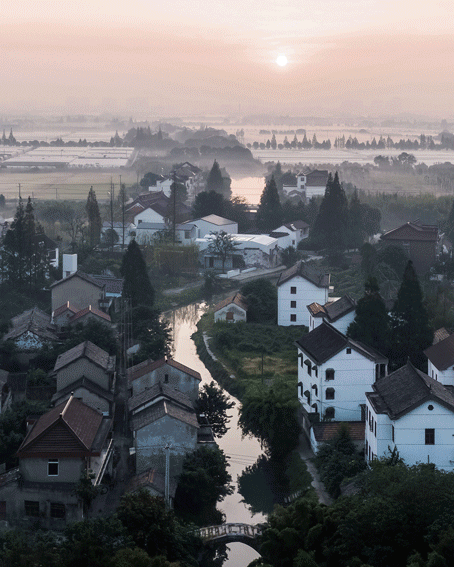
Zhang Yan Village is located in Chonggu Town, in the western suburbs of Shanghai. In recent decades, the demographics of the village have changed dramatically, with a rapidly declining young population, which has had as a result the deterioration of the original village. The town includes houses from the Qing Dynasty, of the Republic of China, and two- or three-story houses built after the founding of the People’s Republic of China. As part of a new sub-urban development policy, Zhang Yan Village, like many other villages and towns in China, has embraced renovation and revival. “Preservation, Growth, and Expansion” is our strategy for the renovation and rehabilitation of Zhang Yan Village and other similar villages in China. It does not aim to dominate and reconstruct, nor to repair the old as old. Rather, it strives to follow the development and context of history, to put contemporary needs and consciousness into the village, to reorganize the layout, program the commercial ecology, and to create a dialogue between the new and the old. Old buildings embody the history and culture of the ancient village. They must remain and be improved by means of reinforcement and preservation. For the dilapidated buildings whose interior space is no longer available, “cleaning up” the broken parts effectively retain the functional ones. Growing naturally out of its context, the “new” can therefore coexist with the “old.” The new buildings represent a new era and, specifically, new functions. The museum features several contemporary buildings, constructed on the vacant parts of the site.
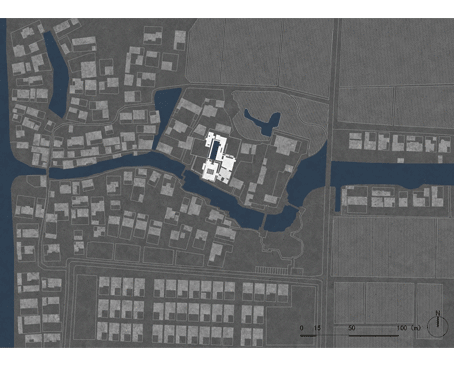
02
鼓楼七号院 | RSAA /Büro Ziyu Zhuang
Courtyard No.7 Of The Drum Tower | RSAA /Büro Ziyu Zhuang
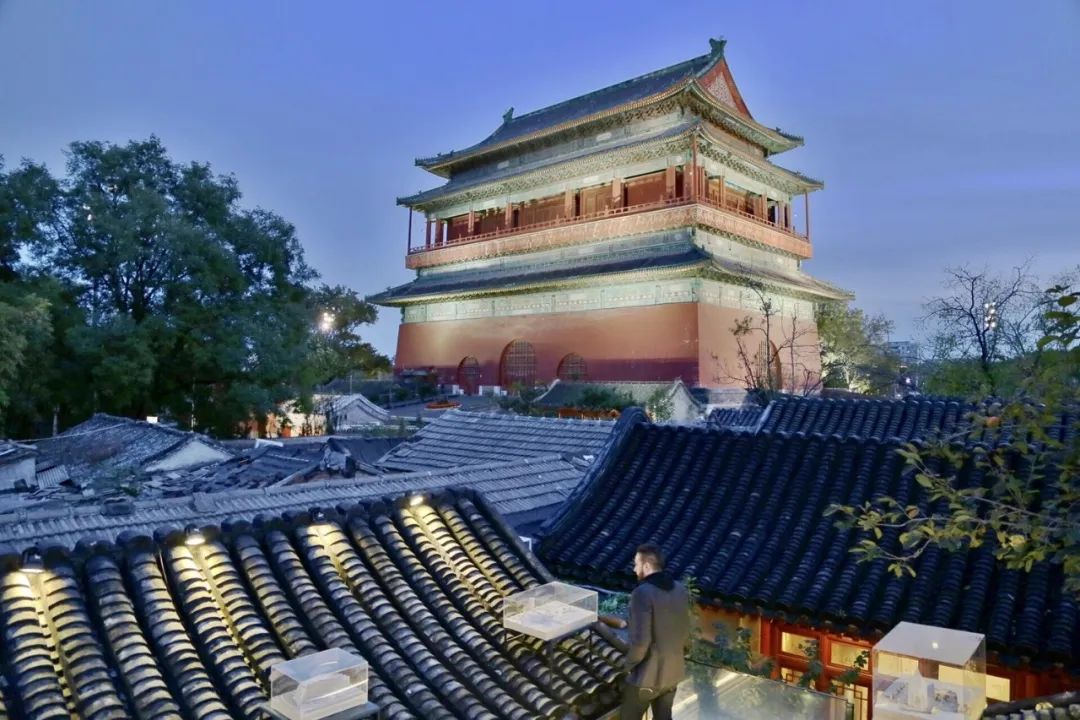
中德办公室RSAA /Büro Ziyu Zhuang对其在北京中轴线的办公室进行了翻新。该项目毗邻600多年以来北京最高的古代地标-鼓楼和钟楼,采用的是传统的北京式庭院;东郊干胡同的四合院。设计目标是建立一个永恒的工作室,同时将周围的文化环境融入庭院的设计。因此,整修分为四个步骤:1.使用传统方式翻新旧部分;2.插入“永恒盒子”作为“功能程序编制系”;3.改造新庭院空间的入口;4.在新界面的链接下组织新的空间序列。为了实现这些目标,在清理了一些不必要的旧界面并暴露了原始的传统结构之后,庄子玉和他的团队建造了一个由玻璃制成的独立的T形体量,将原来的北室,西室和东室结合起来,形成更高效的工作环境。通过上面介绍的逐步方法,庄子玉将具有一个图像的单个院子空间转换为遵循其自身叙述秩序的多层空间。因此,一些小的有趣空间将沿着新路径呈现。T型体量西北翼的一个小院子里摆满了来自不同房间和人造绿色植物的AC室外机,作为不透明玻璃墙后面的“伪装的绿色照明井”。厨房空间与其邻居共用墙壁,同时重复使用原始的结构组件(红色)和原始的瓷砖(绿色)。T型体量的东北翼上的一个书架也充当着通往屋顶水平的楼梯的角色,在那里将两座古老塔楼的景观引入了庭院。同样,在这种情况下,倾斜的屋顶在加固了装载结构之后成为了办公室聊天,社交聚会活动空间的第三层,甚至可以成为员工放松休息的地方。北部房间的高处空间成为模型展示空间,与重新揭露的传统结构构件如椽、新月形梁和檩条一起,用木制模型创造出一种非常强烈的建筑“形象”,这一概念也与RSAA的设计理念紧密相连。
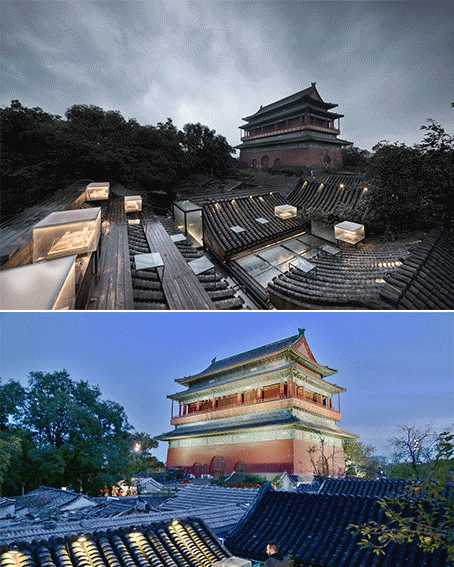
The Chinese-German office RSAA/ Büro Ziyu Zhuang renovated their office in the Beijing central axis. The project, which is next to the tallest ancient landmarks of Beijing for more than 600 years – Drum Tower and Bell Tower- is adopted from a traditional Beijing-style courtyard; Siheyuan in Dongjiaogan Hutong. The design target was to build a timeless workshop whilst embracing the surround cultural context into the yard. Therefore, the renovation was organized into 4 steps; 1. Refurbishing the old section using the traditional method; 2. Insert a “timeless box” as a “functional generator”; 3. Reform the interface of the new yard space; 4. Organize the new space sequences under the link of the new interfaces. To achieve the goals, after cleaning up some old unnecessary interfaces and exposed original traditional structures, Ziyu Zhuang and the team built a free-standing T-shaped volume made with glass to combine the original northern room, western room and eastern room in order to form a more efficient working environment. With the step-by-step approach explained above, Ziyu Zhuang converted a single yard space with one single image into a multi-layered space that follows its own narrative sequence. Some small interesting spaces, therefore, appear along the new path. One small yard on the north-western wing of the T-shape volume was filled with AC outdoor units from different rooms and artificial green plants as a “camouflaged green light well” behind an opaque glass wall. The kitchen space shares the wall with its neighbor, whilst reusing the original structural components (red) and original tiles (green). One bookcase on the north-eastern wing of the T-shape volume also plays a role as a staircase to the rooftop level, where the views of the two ancient towers are introduced into the yard. Also, in this case, after strengthening the structure for loading, the pitched roof become the 3rd level of the activity space for office chatting, social gatherings and can even be a place for staff to relax and take a nap. The high space in the northern room became the model display space, and together with the re- exposed tradition structural components such as the rafters, crescent beams and purlins, creates a very strong architectonic “image” with the wooden models, a concept that is also linked tightly with RSAA’s design philosophy.
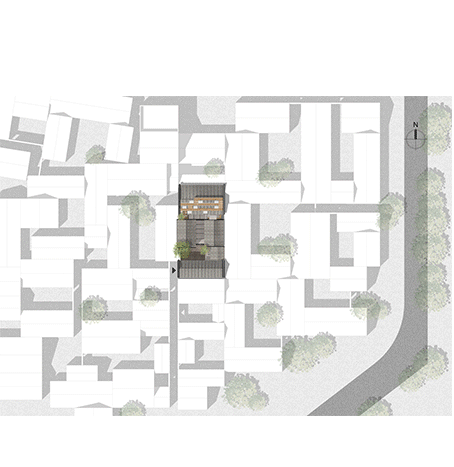
03
莫干山大乐之野庾村民宿 | 直造建筑事务所
Lost Villa Boutique Hotel in Yucun | Natural Build
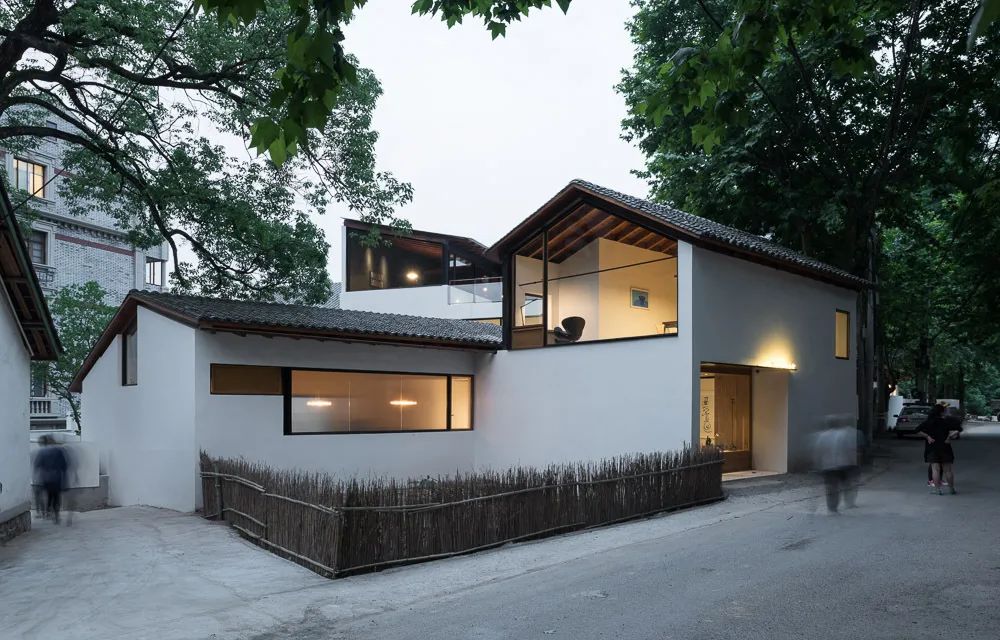
项目基地位于浙江莫干山镇庾村国营时期蚕种厂的西侧,顺着山路可上到莫干山顶。场地从西北角转入,由北向南逐渐跌落。北侧紧邻村舍,曲折退进;南侧沿小溪蜿蜒延展,视线开阔;历史遗留下来的用地权属界定了犬牙交错的边界。旧有的建筑散落在场地上,有些已破旧坍塌;对岸建设中的环山路以及废弃小学的未来状况亦难以估计; 树木填充了村落肌理的剩余空间。这是很日常的当代中国乡村的景观,是混杂的也是动态的。因此,设计的考量是在调和当下周边多变的限制,以及对未来动态的预判下同时来展开的。风景内化的策略不仅是建立对于不利外部的防御性,反之也让被渗透的内部成为景观中一部分。同时设计师希望为小镇提供一些可共享的公共空间,例如拥有独立出入口的咖啡厅、小型展览空间以及放置在三楼的餐厅,这也造就了公共区与民宿之间特殊的流线关系,和多样的游走体验。民宿的客房尽量都设置在中心体量的南侧以获得充足的日照和更延展的景观。西侧的凉廊和泳池区,既作为民宿入口的引导隔离开道路,也与中心体量围合成仅供内部使用的开放性庭院。最东侧的体量相对独立隐蔽,作为家庭化使用的独栋是最为合适的。场地上的百年香樟和梧桐树,和远处的山景成为多角度反复借用的视觉对景。窗景的思考延伸到每个房间,取得了不同的客房平面和窗户视线的关系。设计抓住了布局与内部的拓扑关系,而在具体性放了一手,让策略性的思维超越了概念,最终呈现一种自然的姿态。
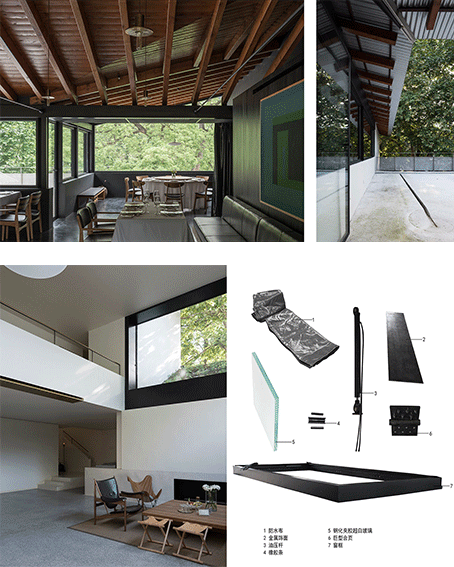
Located at the southwest corner of a previously state-owned silkworm farm in Yucun, Moganshan, Zhejiang Province, the project is connected to the peak of Moganshan Mountain by a mountain trail. The site can be accessed from the northwest corner and the terrain is gradually lowered from the north to the south. There are cottages standing adjacent with jagged outline on the north, whereas the southern end opens up to a panoramic view of a meandering stream. The historical legacies of lands ownership in neighborhood shape the irregular boundary of the site. Existing old buildings scatter on the ground, some of which have even collapsed; an abandoned primary school stands on the other side of the river, whose prospects still remain unknown; trees fill up the left over voids among the rural fabrics. This is the typical landscape condition of contemporary Chinese rural area, both heterogeneous and dynamic. The design is therefore constrained and as well motivated by both the dynamic present and the unpredictable prospects. The strategy of internalizing scenery, not only establishes a defensive gesture against the unfavorable surrounding conditions but also turns the saturated inner space into part of the landscape. At the same time, the designer wants to provide a series of public programs for the locals, such as the café (with its own separated entrance from the hotel), the small exhibition area and the restaurant on the third floor. The arrangement of programs creates a unique circulation between public space and hotel area, and various promenade experience. Most of the guestrooms are designated into the southern part of the main building to obtain sufficient sunlight and panoramic scenic views of the garden. At the west end, there are a loggia and a swimming pool, which frame the main entrance and create a perimeter that buffers the site from the main road. Together with the main building, the loggia forms an open backyard area that serves only hotel guests. As for the building on the east end, it is an independent and secluded villa that can be rented out to an entire family. Taking advantage of the site’s hundred-years-old Camphor and the Platanus trees and even the distanced mountains, the design frames scenes to create a sequence of dynamic views from the building. The framing scenery interacts differently with the layout of each individual room, and diversifies the relationships between each room’s plan and the window. While the design emphasizes the topological play of the programmatical layout and the interior scenery, it stops at the level of specificity, allowing strategic thinking surpass the concept. Eventually, the design presents a more natural gesture. The structural system of the design is a hybrid of mixed masonry structure and wood-and-steel-trusses, which is able to strike a balance between budget and aesthetic. The design aims to achieve a type of optical precision, which is not about the precision of construction details, but, on the contrary, about creating a dialogue between the details and their background scenery. On the one hand, the detail design process aims to respond to such typical problems that one encounters when building in rural China. This includes poor construction quality, the lack of infrastructure and limited product supply. It is through an closely collaborative process that operated throughout the entire design and built development between us (the designers), prefabrication suppliers and local craftsmen that these respective issues are resolved. A series of steel/wood window and door systems, interior plywood doors, extra large automatic window as well as a series of customized light fixtures and furniture are all the product of this collaboration effort. On the other hand, the detail design is otherwise the reaction to the inevitable construction errors and the sudden changes of local constraints. As a result, these accidental issues induce a series of improvisational designs on site.
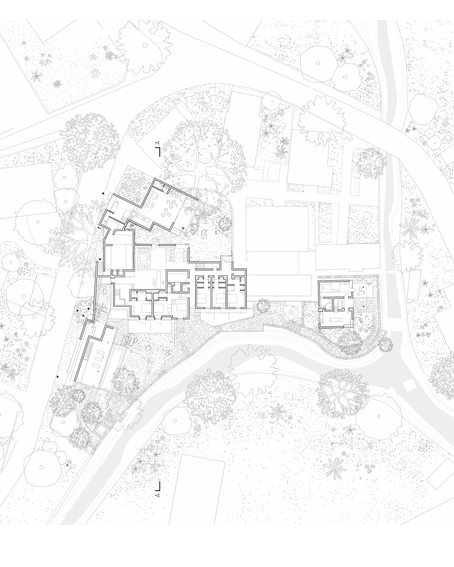
04
混沌大学教学中心,重庆 | 几里设计
Chongqing Chaos University Teaching Center | VARY DESIGN
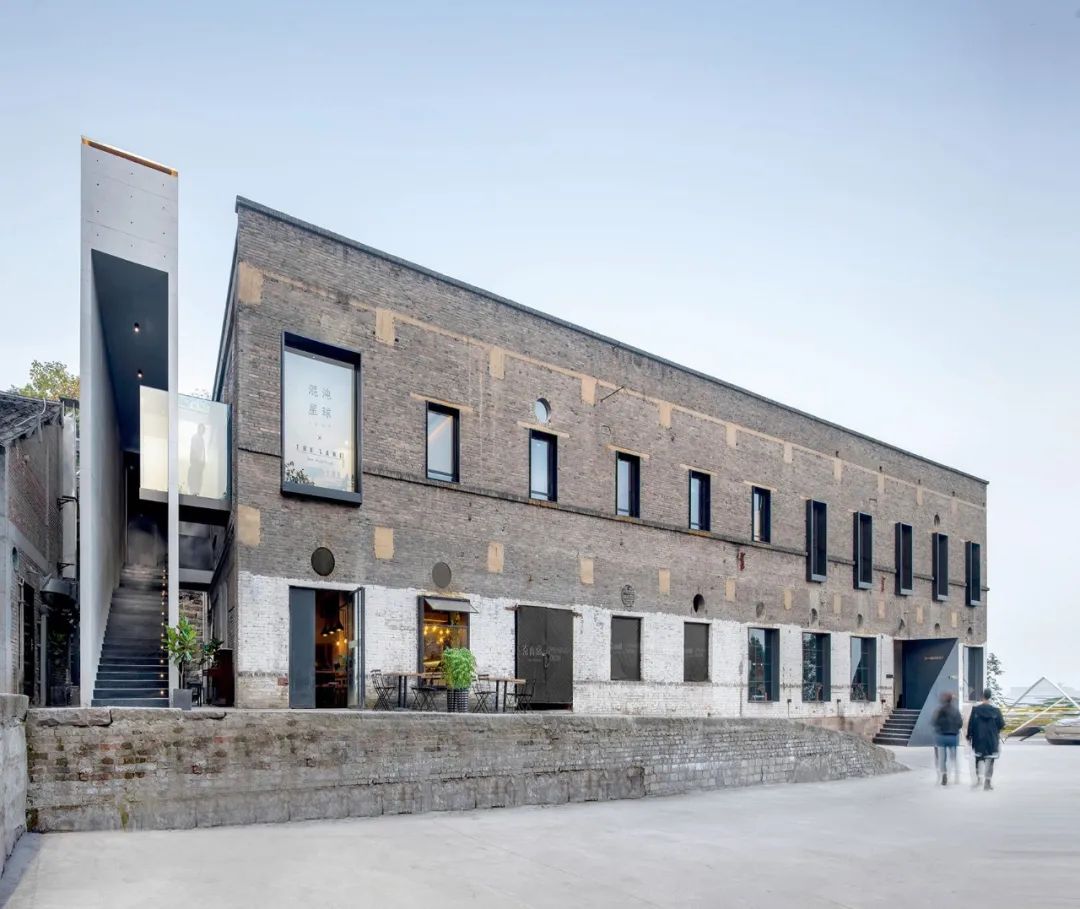
本项目位于重庆市鹅岭印制二厂文创公园(原民国中央银行印钞厂),坐落在鹅岭山地之上,拥有极佳的视野面朝嘉陵江。本项目是为混沌大学(一个21世纪的网络大学)在重庆打造的一个教学中心。如何打造一个新时代新形式的教育性空间是本次设计的挑战。首先在设计决策角度,决定选取采用适应性设计策略,即选取现存有特色的半废弃建筑进行改造,而非新建;然后和混沌大学一起,选取了在网络上广受年轻人欢迎和喜爱、并且有着强烈工业化特质的鹅岭印制二厂文创公园;并将其中一栋沿江、有着辨识性极强的11跨连续拱顶的7号楼作为基础,对其进行改造和加建。设计团队的分析得出,网络大学的教学中心不再是单一性质的教学空间,而更多的应该是一种趣味性质的分享空间:不仅分享知识经验,而且交流爱好、游戏、食物等。于是在设计层面上,打破了传统的此类空间组织形式,反转使教学空间成为了辅助,围绕着作为核心的讲座空间、展示空间、交流空间和餐饮空间而展开。值得一提的是,在设计中,所有的内部空间属性都是可以相互置换的,这样的空间组织方式也使得整个场所拥有了更强得开放性和适应性。入口空间采用新建的现浇混凝土与玻璃材质与老建筑的砖材形成有趣而强烈的对比。作为入口的混凝土盒子,与镶嵌出挑的画廊玻璃盒子,还有保留翻新的老楼砖盒子,形成了一种相互穿插,平面立体化的“透明性”空间。通过材料的运用和空间几何形态的塑造,设计师赋予了一个废旧的老建筑以全新的功能形态和意义。这样的模式将会成为一种未来网络大学教学空间在城市实践层面的一种原型。
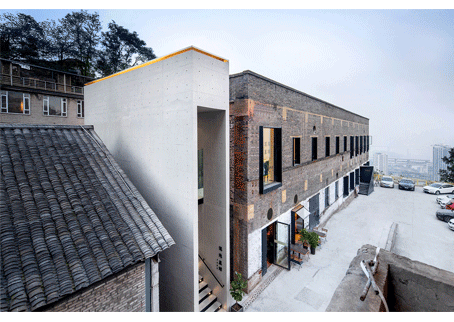
The project is located in TESTBED 2, an innovation campus regenerated from the previous Chongqing No. Printing Factory which also known as Central Bank’s Banknote Printing Factory of Republic of China. It sits on the top of topographical Eling Park with excellent views towards Jialing River. This project is an educational center in Chongqing for Hundun University, a 21-century internet based university. To create a new form of educational space fitting the contemporary context is the biggest challenge for us. Firstly we set up the overall strategy as adaptive design, meaning recycling the derelict buildings rather than building new constructions. Secondly, together with Hundun University we selected the site of BESTBED 2 with strong industrial characteristics that widely welcomed and favored on internet by the youth. Next we decided to do the renovation and extension of the Building-7, a building with a unique feature of eleven-continuous-arch structure. According to the analysis, the education center for an internet-based should no longer be singular function of education, but rather should be a happy sharing space, to share both knowledge and experience but also interests, gaming or foods. In the design, designer reversed the layout pattern of traditional educational facilities, instead, making educational space as supportive space to surround the different cores of lecturing, exhibiting/gallery, leisure/gaming and dining space. Noticeably, the design proposal makes the place with higher openness and adaptivity that all the space is interchangeable inside the building. The entrance of the space is in the material of poured concrete and glass in high contrast with the brick material of the old factory plant. The concrete box of entrance, and the plug-in glass box of gallery, together with the brick box of old factory plant, form a three-dimensional “transparency”. Through the manipulation of materials and form, the designer implanted a brand-new life with new functions and meanings into a previous derelict warehouse. This whole process as an urban practice would be a prototype of the development of internet university in the physical conditions.
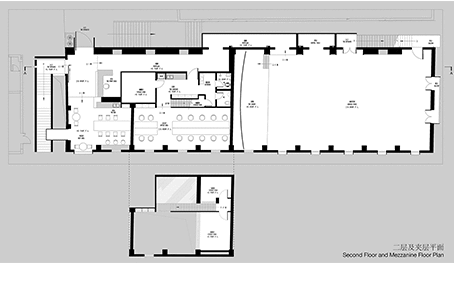
05
8号建筑立面改造 | 阿科米星工作室
Antiroom II:Elena Chiavi,Ahmad el mad and Matteo Goldoni
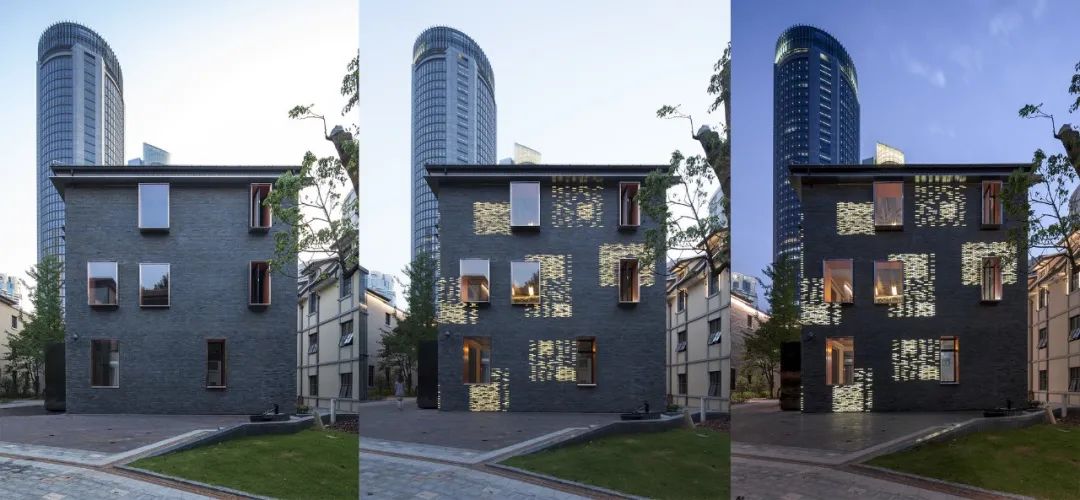
该立面翻新工程仅是上海衡山坊历史区再生计划的一小部分。该建筑位于市区商业中心,在两条绿树成荫的历史街道的拐角处。这座古老的别墅是未来的精品店或办公室,现在被两种不同纹理的表皮覆盖,传统的灰色砖石与独特的发光砖块拼贴在一起。具有相同的比例和相似的颜色,两种材料在白天具有相同的静谧的外观,但是当夜幕降临时,新的砖块突然变得光亮。多么戏剧性的体验!附近的行人总是被深深吸引。精心设计的构造细节营造出与这座历史建筑具有凝聚性的面孔,但在不同的时间表达却完全不同。对于建筑工作室阿科米星,改变材料和构造只是为了使这些日常商业建筑具有与日常不同的体验。
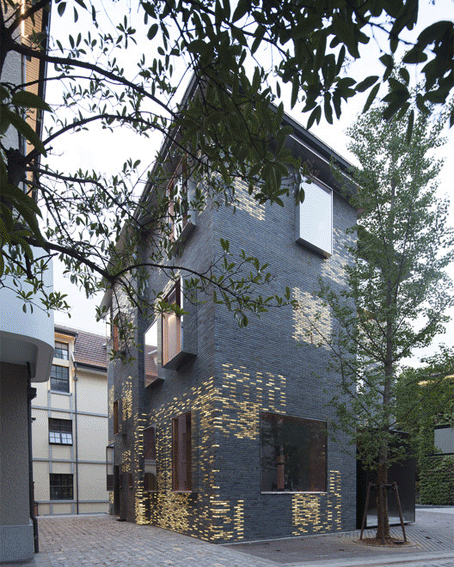
This façade renovation project is a small part for Hengshanfang Historical Area Regeneration Program, Shanghai. The building locates in a downtown commercial center, at the corner of two leafy historical streets. This old villa, future boutique shop or office, is now covered with a skin of two different textures, traditional gray bricks mixing with unique luminous bricks.With the same scale and similar color, both materials share the same quiet appearance during the day, but when night falls, the new bricks suddenly become shinning. What a dramatic experience! Pedestrians nearby are always deeply attracted.The tectonic details are carefully designed to create a coherent face for this historical building but completely different expression during different time. For Atelier Archmixing, to change materials and tectonics is simply to achieve difference for these everyday commercial buildings.
